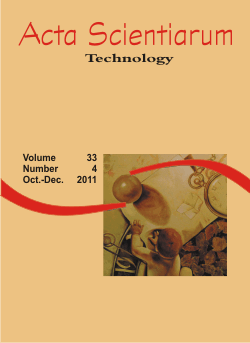Effect of fermentation parameters on ethanol production from cassava liquid residue (manipueira)
DOI:
https://doi.org/10.4025/actascitechnol.v33i4.9279Keywords:
Cassava, residue, ethanol, chromatographyAbstract
“Manipueiraâ€, a liquid residue from the processing of cassava starch and flour, has recognized high pollution potential. Aiming at a possible use of “manipueira†as raw material for ethanol production, this study aimed to evaluate the effect of the percentage of inoculated yeast and fermentation temperature on the chromatographic profile of the components of wine of “manipueiraâ€. The residue was characterized for starch and sugar content, as well as pH and total acidity. The residue was hydrolyzed by the action of enzymes Termamyl 120 L and AMG 300 L. The hydrolysate obtained was fermented under different experimental conditions. A factorial central composite design (22) with two independent variables and the response surface methodology were used to evaluate the results. The results showed a significant effect of variable parameters on the components of wine. The conditions of low fermentation temperature and lower percentages of inoculated yeast were the most appropriate to obtain ethanol from “manipueiraâ€.Downloads
Download data is not yet available.
Downloads
Published
2011-05-18
How to Cite
Suman, P. A., Urbano, L. H., Leonel, M., & Mischan, M. M. (2011). Effect of fermentation parameters on ethanol production from cassava liquid residue (manipueira). Acta Scientiarum. Technology, 33(4), 379–384. https://doi.org/10.4025/actascitechnol.v33i4.9279
Issue
Section
Biotechnology
License
DECLARATION OF ORIGINALITY AND COPYRIGHTS
I Declare that current article is original and has not been submitted for publication, in part or in whole, to any other national or international journal.
The copyrights belong exclusively to the authors. Published content is licensed under Creative Commons Attribution 4.0 (CC BY 4.0) guidelines, which allows sharing (copy and distribution of the material in any medium or format) and adaptation (remix, transform, and build upon the material) for any purpose, even commercially, under the terms of attribution.
Read this link for further information on how to use CC BY 4.0 properly.
0.8
2019CiteScore
36th percentile
Powered by 



0.8
2019CiteScore
36th percentile
Powered by 

















8.png)




